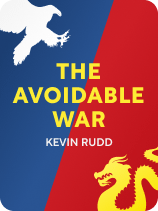

This article is an excerpt from the Shortform book guide to "The Avoidable War" by Kevin Rudd. Shortform has the world's best summaries and analyses of books you should be reading.
Like this article? Sign up for a free trial here.
Is a war between the US and China inevitable? What’s the history and the future of US-China relations?
Hostility between the US and China has been growing for over a decade, eroding the wary but pragmatic relationship of years past. Now, as tensions threaten to escalate, diplomat and politician Kevin Rudd argues that a full-blown military conflict can and should be averted.
Continue reading for an overview of The Avoidable War, Kevin Rudd’s analysis of this critical situation.
Overview of The Avoidable War by Kevin Rudd
In The Avoidable War, Kevin Rudd describes the US and China as opposites perpetually at odds with one another—the US being a democratic capitalist nation and China an authoritarian socialist nation. Nonetheless, the two global powers have maintained a strategic relationship in which both benefited from each other’s economic markets despite their ideological differences.
Rudd argues that this tenuous relationship is unraveling due to a combination of Chinese President Xi Jinping’s strategies and priorities, the US’s reactions to China’s rise to global prominence, and deep mistrust and ideological differences on both sides. In The Avoidable War, published in 2022, Rudd explains the complex factors contributing to hostility between the US and China and makes a case for how they can avoid full-on war—an outcome that would take a huge toll on the US and China as well as global stability.
Rudd began his career as an Australian diplomat in Beijing. He served as Australia’s prime minister from 2007 to 2010 and as foreign minister from 2010 to 2012. He now acts as the Australian ambassador to the US. His foreign policy expertise is in the Asian-Pacific region, and he was the president of the Asia Society Policy Institute—a research institute dedicated to Asian policy challenges.
Since American readers may not have a strong understanding of Chinese political thought and Xi’s Marxist-nationalist ideology, Rudd first explains the key components of Xi’s domestic and global strategies to help readers understand why tensions between the US and China have escalated in recent years. Rudd also contends that a US-China war would be catastrophic and recommends that the two countries restabilize their relationship through strategic cooperation.
Historic Context on the US-China Relationship
Rudd explains that to understand the modern-day relationship between the US and China, we must first examine the long history between the two countries: the events that have damaged their mutual trust and the ways they have strived to gain mutual benefits. We’ll start with a timeline summarizing key events in US-China relations.
19th-Century Imperialism: Animosity Between the US and China
The 19th century was an era of imperial expansion for many European nations and the US. During this period, foreign powers annexed Chinese territory and ended its isolationism. Rudd writes that the First Opium War from 1839 to 1842 was one of the first impetuses for hostility between the US and China.
At the end of this conflict, Rudd explains, Britain forced China to open its ports to international trade.
Rudd explains that although the US was uncomfortable with this policy of forcing China to open to global trade (because of the policy’s imperialist nature and the US’s anti-colonial history), the US also wanted to benefit from the economic opportunity it would create.
This open-door policy gave the US access to China for trade and for American missionaries. The presence of missionaries fostered an anti-foreign sentiment in China, particularly among the Chinese elite, who viewed them as cultural interlopers.
Rudd says that, from the 1850s through 1900, several foreign powers annexed Chinese states. The territories lost to colonial powers included Vietnam (annexed by France in 1858) and Korea (annexed by Japan in 1895). China condemned the US for refusing to help China resist invasion despite its official policy of supporting China as an independent nation.
Then, in 1882 the US passed the Chinese Exclusion Act—legislation barring Chinese immigration to the US that angered Chinese people in the US and China.
Rudd writes that another key event in the two countries’ relations was the Boxer Uprising of 1900. He describes this as a violent uprising by Chinese citizens against Christian missionaries and foreign presence in China, including the US, European nations, Russia, and Japan. During the Uprising, Chinese rebels attacked foreign diplomats, and the US and other foreign powers ended the uprising using military force.
20th Century: Back and Forth Relations Amid Multiple Wars
The 20th century was characterized by ups and downs in the US-China relationship as a result of American immigration policies, a series of wars that ultimately damaged the two countries’ alliance, and China becoming a nuclear power. In 1905, the Chinese initiated a boycott of American goods as a direct response to the Chinese Exclusion Act (which was extended in 1902) as well as violence against Chinese immigrants in the US.
Then, in 1917 the US and China entered World War I. Rudd explains that both countries fought against Germany in WWI, with China expecting to regain its German-occupied territory of Shandong at the end of the war. However, when the Allies won and it was time to formally establish a treaty, the US, France, and Britain went back on their word: They rejected all of China’s primary demands—including returning China’s German-occupied territory of Shandong. Instead, the Shandong territory was given to Japan (which also fought with the Allies) as an incentive for Japan to join US President Woodrow Wilson’s League of Nations—a new international governing body.
From 1939 to 1945, China fought in World War II on the Allied side. For China, the war began when Japan invaded China in 1937. At that time, the US didn’t offer material support for China, although its official diplomatic stance was sympathetic toward China. The US entered the war in 1941 but didn’t deploy troops to China, instead focusing efforts on islands in the Western Pacific (in addition to fighting on the European front of the war). The US ended the war with a nuclear attack on Japan in 1945. In 1947 during the Marshall Mission—a diplomatic effort led by President Harry Truman after the war—the US tried (and failed) to help China create a unified government that would include both Nationalist and Communist Party members.
In the aftermath of WWII in 1946, China’s civil war began between the Nationalist Party and the Communist Party. The CCP prevailed in 1949 and officially named the country the People’s Republic of China (PRC). The Nationalists (the opposing political group) fled to the island of Taiwan and created a separate government they called the Republic of China (ROC). After the Chinese civil war ended, both the Nationalist ROC in Taiwan and the Communist PRC on the mainland claimed that they were the legitimate Chinese government.
Rudd writes that the next key event happened when China entered the Korean War in 1950. China unofficially declared war on the US by supporting North Korea after Americans crossed the 38th parallel in Korea (a demarcation at 38 degrees of latitude north of the equator). During this time, China also launched a domestic anti-American propaganda campaign.
Next, Rudd explains that a conflict in the Taiwan Strait in the 1950s further damaged China-US relations. During this incident, US President Dwight Eisenhower threatened nuclear attacks on China in retaliation for China’s military attacks on Taiwan and other islands.
In another major development, China gained nuclear weapons in 1964. Rudd writes that China’s official stance has been to use its nuclear arsenal as a deterrent against nuclear attacks by Russia and the US. However, he also contends that given the recent increasing tensions between the US and China, this may not continue to be true (implying that China may consider an offensive nuclear attack). Over the last several years, China has significantly expanded and upgraded its nuclear arsenal.
US and China Establish a Formal Diplomatic Relationship
After years of oscillating alliances and tensions, the US and China formally normalized their diplomatic relationship in 1979. Under the leadership of US President Richard Nixon, the two countries established a working relationship for practical economic and political reasons.
The process of opening relations with China started years earlier in 1971, when the US still hoped for an ally in East Asia to help end the Vietnam War. China had initially supported the Viet Cong in North Vietnam during the war but later reduced its military aid in the form of weapons and training. The US also wanted to have China as an ally to gain leverage over the Soviet Union in negotiating arms control agreements. Lastly, the US hoped that as China’s economy grew it would eventually liberalize—meaning it would engage in free trade, which would benefit the US economically.
On the other hand, China hoped that the US would protect it from potential military aggression from the Soviet Union, provide China with military intelligence and equipment, and boost China’s economy through temporary trade relations. China’s relations with the Soviet Union had collapsed throughout the 1950s-1960s (a rift partly caused by differing political ideologies between Soviet leader Nikita Khrushchev and Chinese Chairman Mao Tse-tung), leaving China in a desperate financial situation when the Soviet Union ended its economic aid. This made China even more keen to strengthen economic ties with the US.
Early Flaws in the Pragmatic Relationship
Rudd emphasizes that this mutually beneficial partnership between the US and China led to a key misunderstanding in the two countries’ relationship. The US expected that, because a trade relationship between them was emerging, China was on its way to becoming a liberal, capitalist, democratic state like the US. On the other hand, China—which was now ruled by the CCP—viewed the US as a necessary and temporary measure to build an economically self-sufficient, communist state in the long term.
For China, trade relations with the US weren’t a sign of its fundamental transformation into a democratic, capitalist state. China’s resistance to significant political reform has been evident over the years in events such as Tiananmen Square, in which the Chinese military violently suppressed a protest in 1989 by students demanding democratic reform.
Another sticking point in their diplomatic relations was the issue of Taiwanese sovereignty. China wanted to regain full control over the island of Taiwan, which had formed a separate government ruled by the Nationalist Party that fled mainland China after the Chinese civil war. The US hindered this goal by establishing diplomatic relations with Taiwan and providing them with military assistance. Although military and economic cooperation continued between the US and China, the Taiwan issue would continue to stymie relations between the US and China for decades.
Xi’s Priorities and Strategies
This context on the ups and downs of historic relations between the US and China leads us to Rudd’s next area of focus: China’s shifts in domestic and international policies under the leadership of President Xi starting in 2013. Rudd explains that Xi’s goals—and the shift they represent from previous years—are key to understanding why tensions between the US and China have escalated over the last decade.
Under the previous leadership of Deng Xiaoping from 1978-89, China was focused on growing the economy through increased global trade and opening to foreign investment, which the US benefited from. The transition to Xi’s administration signaled a shift because China had now achieved the economic stability required to expand the scope of its priorities in ways that threaten the global supremacy of the US.
Rudd writes that Xi’s key priorities include keeping the CCP in power through strategic economic reforms, restoring Chinese territory, and increasing China’s global influence. In this section, we’ll describe each of these strategies in more detail as well as how they contribute to China’s power struggle with the US.
Maintaining the CCP’s Power Through Economic Reform
According to Rudd, the core of Xi’s vision is retaining control over the CCP, keeping the CCP in power in China, and using Marxist-Leninist ideology to guide the country’s economic policies. Rudd says that because the CCP is rooted in Marxist-Leninist ideology, which prioritizes the economic well-being of the populace, economic prosperity for the Chinese people is Xi’s primary strategy for keeping himself and the CCP in power.
According to Rudd, the Chinese people will be content with the CCP as long as unemployment stays low, the standard of living continues to rise, and disparities of wealth stay low. If the economy falters, however, Xi and the CCP would face political backlash and risk losing power. Xi’s economic reforms—rooted in these driving forces—are referred to as the New Development Concept (NDC).
Rudd writes that the NDC contributes to tensions with the US because it differs from American ideology about free market capitalism and because of its direct economic impact on the US.
In contrast, the US culturally venerates and legally protects private enterprises. Rudd suggests that both the US and China fear that the economic ideology of the other could threaten their own by fostering internal political resistance.
In addition to the ideological differences between the two economic models, Xi’s NDC directly influences the US economy in negative ways (from the US perspective).
Restoring Chinese Territory by Increasing Military Power
The next key priority of Xi’s that Rudd discusses is national unification—a goal Xi wants to achieve by restoring and protecting Chinese territories by increasing China’s military power. China wants to maintain its control of Hong Kong, Tibet, Inner Mongolia, and the state of Xinjiang. It also aspires to fully reunify with Taiwan and the Senkaku Islands in Japan.
This priority escalates tensions with the US because the US no longer has a major advantage over China in terms of military capability as a result of China’s military upgrades. This limits the US’s ability to reinforce its political interests abroad solely based on its military superiority since China could retaliate.
Rudd writes that China has been upgrading its military in terms of equipment and training and has been increasing its naval activity in the South and East China Seas to intimidate some of the places (like Taiwan) that it aims to reunify with China. He asserts that China also conducts military patrols in the area to deter US intervention in a potential military conflict.
China has claimed all of these places, but they don’t necessarily want to be part of China. Rudd suggests that although China also uses political and economic strategies to exert control over these territories (which concerns the US for the reasons discussed in the previous section), the strengthening of the Chinese military is particularly troubling to the US.
Increasing Influence Through Investment and Global Structures
Xi’s third key priority is increasing China’s global power through investment in developing countries and by influencing global institutions. Rudd says that through these actions, China is challenging the geopolitical status quo—what he refers to as the “global rules-based order”—by becoming a key economic and political player. The components of the geopolitical status quo include things like development models for investing in low-income countries and the rules of governing bodies such as the World Trade Organization (WTO) and the UN.
One key tool for asserting strategic global power is China’s Belt and Road Initiative (BRI), an infrastructure project to revive China’s historic trade relations and increase the country’s economic ties to Europe, the Middle East, and South Asia.
Rudd claims that the BRI contributes to China’s power struggle with the US because the BRI’s success would place China in a more favorable diplomatic and economic position with countries around the world. This means that China would challenge the US as the most influential nation, and China would be less likely to face international backlash for its actions abroad (like military action against Taiwan) or domestically (such as human rights abuses).
Another aspect of the BRI includes investment in infrastructure (like telecommunications) and business projects throughout the developing world. Rudd argues that this investment has two major benefits for China: It increases access to raw materials and markets for Chinese products, and it provides political leverage over the US.
The Current Status of US-China Relations
Rudd suggests that Xi’s strategies for bolstering China’s domestic and international power have caused increasing hostility between the US and China. Overall, he contends that each side views the other as an existential threat, and neither side believes the public stances of the opposing government. He writes that the last decade has been marked by several events triggering a downturn in US-China relations: increased cyberattacks by both sides, China’s heightened military presence in the South China Sea, former President Donald Trump’s trade war with China in 2018-2019, anti-China rhetoric by the US during the Covid-19 pandemic, and the US’s high-level diplomatic meetings in Taiwan.
Rudd says these events and the loss of trust that resulted have hindered the countries’ ability to cooperate even on a practical level, such as by maintaining beneficial trade relations. In this section, we describe Rudd’s summary of the US and China’s different perspectives.
The Chinese Perspective
Rudd explains that economically, China believes it has the right to acquire influence and political clout abroad through investment and trade, just as the US has done for decades. China would argue that its development model in particular is superior to the US’s because it doesn’t come with conditions about how the beneficiary’s government has to operate.
In addition, China resents US presidents’ recent actions such as Trump’s trade war, which caused China economic distress due to policies like high tariffs on Chinese goods imported to the US.
Rudd contends that China also views many of the US’s actions through the lens of race, citing Trump’s use of the term “China virus” during the Covid-19 pandemic.
Rudd points out that, although the administration under President Joe Biden has tamped down anti-China rhetoric, it hasn’t reversed many of the Trump-era sanctions on China (including tariffs and visa restrictions) leaving this point of tension with China unresolved.
Politically, China would argue that the US government has always exerted its will through violent and coercive means, and it has also committed human rights violations against minorities within its own borders. Therefore, Rudd explains, China would say that American criticisms of China are hypocritical.
The American Perspective
Rudd explains that economically, any unwillingness to participate in free market capitalism is a direct threat to the US’s goal of establishing a global order that aligns with its capitalist economic interests. This includes economic policies such as tariffs and China’s largely state-controlled economy. Similarly, Rudd writes that the economic and military advancement of any nation with Marxist-Leninist ideology challenges the supremacy of the US model of a liberal-style, capitalist democracy.
According to Rudd, Trump in particular was outraged by the imbalance in trade (in favor of China) between the US and China, considering it harmful to the US’s reputation as well as its economy. This sparked a two-year contentious trade war in which the two countries continued to retaliate against each other economically.
Rudd says that the Trump and Biden administrations also criticized China for its authoritarian oppression of freedom of religion, speech, and press as well as its human rights abuses within China. The US has also been angered by Chinese cyberattacks on private companies. Lastly, the US claims that China’s naval activities in the Pacific infringe on the rights of the independent nations of Southeast Asia.
Consequences of a US-China War and How to Avoid It
Rudd argues that if tensions escalate to a military conflict, a US-China War would be catastrophic on many levels. He claims that a war would take its toll on both countries as well as the global community, and the risks of war make it worth striving for an alternative. Rudd’s most important reason to avoid war is the loss of human life that would result from military conflict.
In addition, Rudd writes that both countries would pay a high economic price if they waged war (for weaponry, equipment, and deploying troops), a war would cause global instability by potentially pulling other allies into the conflict, and both countries would risk losing domestic political power and global prestige if they lost the war or failed to decisively win.
A Three-Part Diplomacy Plan
Rudd’s recommendation for avoiding a war is a form of diplomacy he refers to as “strategic managed cooperation.” His vision for US-China relations has three key parts: establishing clear conditions (what Rudd calls “redlines”) that neither side can violate without risking war, allowing economic and political competition to carry on as usual, and collaborating in areas where it’s mutually beneficial, such as combating climate change.
Although Rudd acknowledges that his plan might appear naive, he also asserts that it’s the best alternative that each country has to avoid a catastrophic conflict. He says that by avoiding it long enough through explicit agreements, political relations might improve organically over time.
Establishing Clear Boundaries
Rudd’s first component of the diplomacy plan is the most important for preventing one country’s actions from accidentally sparking a full-on war. His idea is for both sides to be transparent about actions that are unequivocally off-limits, and importantly, these boundaries have to be verifiable so that each country can monitor the other.
Allowing Normal Competition
Under Rudd’s framework, as long as the US and China didn’t violate the conditions described in the previous section, both countries could continue to engage in economic and political competition without escalating tensions. Economically, this includes activities like competing for access to each other’s consumer and investment markets and tailoring trade policies to their own advantage. Rudd explains that the US and China could continue competition at the ideological level as well—the US promoting democracy and free market capitalism and China promoting its economic development based on authoritarian capitalism.
Collaborating on Key Global Issues
The last part of Rudd’s diplomacy plan is for the two countries to collaborate when it comes to mitigating global challenges such as climate change and nuclear proliferation. Rudd contends that since climate change threatens the long-term economic stability of both countries, and widescale reduction of carbon emissions is critical, both would benefit from collaborative action.
In addition, Rudd writes that the US and China would benefit from preventing countries such as Iran and North Korea from producing nuclear weapons. Nuclear weapons are a threat to the national security of both the US and China and give other countries more political leverage since they can threaten a nuclear attack. Rudd suggests that the US and China could collaborate on this issue by both ratifying the Nuclear Test Ban Treaty and negotiating other agreements to maintain the status quo in terms of nuclear weapons development.

———End of Preview———
Like what you just read? Read the rest of the world's best book summary and analysis of Kevin Rudd's "The Avoidable War" at Shortform.
Here's what you'll find in our full The Avoidable War summary:
- The complex factors contributing to hostility between the US and China
- How a military conflict between the US and China can be avoided
- The huge toll a US-China war would take on global stability






